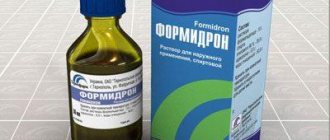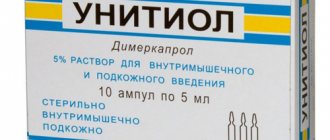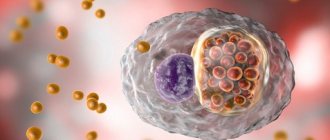Human immunoglobulin is an immunological drug. It is a concentrated solution of an immunologically active protein fraction, which is isolated from the blood plasma of healthy donors by fractionation with ethyl alcohol at temperatures below 0°C.
To produce one batch of immunoglobulin, manufacturers use plasma obtained from at least 1000 healthy donors. They are preliminarily individually tested for the absence of surface antigen of the hepatitis B virus, antibodies to the hepatitis C virus and human immunodeficiency viruses.
At the Yusupov Hospital, immunoglobulins registered in the Russian Federation are used to treat patients. They are highly effective and have a minimal range of side effects.
Release form and composition
Dosage forms of normal human immunoglobulin:
- Solution for intramuscular (IM) administration (in ampoules: 1 ml/1 dose, in a cardboard box of 10 pcs.; 1.5 ml/1 dose, in a cardboard box of 10 pcs. or in a contour plastic package of 5 or 10 ampoules, 1 or 2 packs in a cardboard pack; 3 ml/2 doses, 10 pcs in a cardboard pack; 3 ml/1 dose, 10 pcs in a cardboard pack);
- Solution for intravenous (IV) administration (25 or 50 ml bottles, 1 bottle in a cardboard box);
- Solution for infusion (25, 50 or 100 ml bottles, 1 bottle in a cardboard box).
Active substance – normal human immunoglobulin:
- Solution for intramuscular administration: 1 ml – 100 mg;
- Solution for intravenous administration: 1 ml – 50 mg;
- Solution for infusion: 1 ml – 50 mg.
Immunoglobulin price, where to buy
The price of normal human immunoglobulin for intramuscular administration is 850-900 rubles. for 10 ampoules. Where to buy Human Immunoglobulin in Moscow, Yekaterinburg and other cities, where to get an injection, and how much Human Immunoglobulin costs, you can find out at your nearest medical facility. The price of Immunoglobulin IV is on average 2600 rubles per 25 ml bottle. The cost of an injection (ampoule) in Russia (Moscow, Chelyabinsk, etc.) is about 100 rubles.
- Online pharmacies in UkraineUkraine
Pharmacological properties
Pharmacodynamics
The composition of normal human immunoglobulin includes approximately 90% monomeric IgG and a small amount of a fraction of decomposition products, dimeric and polymeric IgG and IgA, as well as IgM in trace concentrations. IgG subclasses are distributed into fractions in the same way as in human serum.
The drug contains a wide range of neutralizing and opsonizing antibodies that can fight viruses, bacteria and other pathogens. In patients with primary or secondary immunodeficiency, normal human immunoglobulin compensates for the deficiency of antibodies belonging to the IgG class, which reduces the risk of developing infectious diseases.
Pharmacokinetics
After intravenous infusion, normal human immunoglobulin is redistributed between the extravascular space and blood plasma, and an equilibrium state is achieved in approximately 7 days.
The substance penetrates the placental and blood-brain barriers and is also detected in breast milk. The half-life of immunoglobulin is 21 days. In patients with primary hypogammaglobulinemia (agammaglobulinemia), it increases to 32 days.
Antibodies and immunological memory
The immune response is divided into primary and secondary. The primary response occurs during the first contact with the antigen, after which the body produces mostly IgM immunoglobulins, which are then replaced by more specific and stable IgG antibodies.
A secondary immune response occurs upon repeated exposure to the same antigen. It is more intense than the primary one, the concentration of antibodies reaches higher levels than the first time.
This effect is due to immunological memory and the presence of memory in B lymphocytes. These cells live in the body for years, and when they come into contact with an antigen, they begin to divide very intensively and produce specific antibodies.
Indications for use
The use of normal human immunoglobulin is indicated:
- Solution for intramuscular administration: for the treatment of agamma- and hypoglobulinemia; for the prevention of: whooping cough, measles, hepatitis A, meningococcal infection, influenza, polio; to increase the body's resistance to infectious diseases during the period of convalescence;
- Solution for intravenous administration: treatment of severe forms of viral and bacterial infections; for postoperative complications in adults and children associated with septicemia;
- Solution for infusion: idiopathic thrombocytopenic purpura (especially in acute forms in children), treatment and prevention of infectious diseases, congenital immunodeficiency conditions (partial, complete or variable immunodeficiency, severe forms of combined immunodeficiency, Wiskott-Aldrich syndrome), as well as immunodeficiency acquired in as a result of bone marrow transplantation and other types of transplantations, for chronic lymphocytic leukemia, for AIDS in children, Kawasaki syndrome (as a concomitant therapy with acetylsalicylic acid).
Analogs
As an alternative means to stimulate immune defense in young and middle-aged children, other drugs are used. They are also prescribed by a doctor, taking into account the individual characteristics of the body. Analogues of Immunoglobulin are:
- Endobulin;
- Gabriglobin;
- Intratect;
- Pentaglobin;
- Intraglobin;
- Immunovenin;
- Gamunex.
All medications are designed to increase the immune defense of the child’s body. However, priority can be given to a particular drug only after receiving the results of the immunogram and assessing the accompanying indications.
Contraindications
According to the instructions, normal human immunoglobulin in the form of solutions for intramuscular and intravenous administration is contraindicated in the following cases:
- History of severe allergic reactions to the administration of blood products;
- Allergic diseases, including bronchial asthma, atopic dermatitis, recurrent urticaria, as well as a history of a tendency to allergic reactions (for patients in this category, administration of the drug is possible with the simultaneous use of antihistamines, which continue to be administered for 3 days with intramuscular injection and 8 days with intravenous /in the administration of immunoglobulin);
- Systemic immunopathological diseases, including nephritis, blood diseases, connective tissue (if it is necessary to use immunoglobulin, administration should be done only after consultation with an appropriate specialist and against the background of prescribing concomitant therapy).
The solution for intramuscular administration should not be used in infants simultaneously with calcium gluconate.
The use of solution for infusion is contraindicated in patients with selective deficiency of immunoglobulin A (IgA) in the presence of antibodies against IgA and in case of hypersensitivity to the drug.
Caution should be exercised when prescribing the solution for infusion during pregnancy and breastfeeding.
Use of the drug during pregnancy
The role of immunoglobulins is especially important in the treatment of diseases in pregnant women. Their body is extremely sensitive to medications, many of them are simply contraindicated. Immunoglobulins are simply irreplaceable in this situation. They are non-toxic and do not harm the body. These are the drugs that increase the level of a person’s defense system and help him independently overcome the disease or prevent its development.
However, studies on the reaction of the body of pregnant women to the action of the drug have not been conducted, so there is no information about how harmful or harmless normal human immunoglobulin is during pregnancy and lactation. During pregnancy, the drug can be used in situations where there is an urgent need for its administration, if the potential benefits to the expectant mother's body outweigh the possible risks to the fetus.
During breastfeeding, normal human immunoglobulin should also be used with extreme caution, as it can enter the baby’s body through breast milk.
Instructions for use of Normal Human Immunoglobulin: method and dosage
The solution for intramuscular injection is injected into the outer surface of the thigh or the upper outer quadrant of the gluteal muscle (intravenous administration of the drug is prohibited!) Do not store the drug in an opened ampoule, use ampoules with broken markings or seals, if the color of the solution changes or becomes cloudy or the presence of unbreakable flakes, if storage conditions are violated and the expiration date has expired. The ampoules with the drug should be kept at room temperature for 2 hours before administration. The procedure is carried out in compliance with the rules of antiseptics and asepsis. The solution is drawn into a syringe with a wide bore needle to prevent the formation of foam. The dose and frequency of immunoglobulin administration are prescribed by the doctor based on clinical indications.
Recommended dosage of normal human immunoglobulin for prophylaxis:
- Hepatitis A: once, children from 1 to 6 years old at a dose of 0.75 ml, up to 10 years old - 1.5 ml, patients over 10 years old - 3 ml (if necessary, repeated administration is possible only after 2 months);
- Prevention of measles: once, the dose for children depends on the time elapsed since contact with the patient and the condition of the child, and can be 1.5 or 3 ml, in case of contact with mixed infections - 3 ml, adults - 3 ml (indicated for patients from the age of 3 months, who have not had measles and have not been vaccinated against it, no later than 6 days from the moment of contact with the patient);
- Prevention of whooping cough: for children who have not been sick and have not been vaccinated or not fully vaccinated against whooping cough - 3 ml twice with a break of 24 hours for the shortest possible time, but no later than 3 days from the moment of contact with the patient;
- Prevention of meningococcal infection: once, for children from 6 months to 3 years in a dose of 1.5 ml, from 3 to 7 years - 3 ml, during the first 7 days after contact with a patient with generalized meningococcal infection;
- Prevention of poliomyelitis: once in doses of 3-6 ml, in children who are not fully or not vaccinated with polio vaccine, at an earlier time after contact with a patient with poliomyelitis;
- For the treatment and prevention of influenza, the solution is administered once: for children under 2 years of age in a dose of 1.5 ml, from 2 to 7 years of age - 3 ml, for patients over 7 years of age - 4.5-6 ml, for severe forms of the disease repeated doses are indicated (after 24 -48 hours) administration of the drug dose;
- When treating agamma- and hypoglobulinemia, the prescription is made in a dose of 1 ml per 1 kg of patient weight (it can be administered in 2-3 doses with a break of 24 hours). Subsequent prescriptions of the drug according to indications are possible only after 1 month;
- To increase the body's resistance in chronic pneumonia and during the period of convalescence during a protracted course of acute infectious diseases, a single dose of 0.15-0.2 ml per 1 kg of patient weight is indicated. The frequency of administration is prescribed by the doctor, but no more than 4 injections with an interval of 2-3 days.
The solution for intravenous administration is diluted immediately before use with 0.9% isotonic sodium chloride solution or 5% glucose solution in a ratio of 1:4. The prepared immunoglobulin solution is administered intravenously at a rate of 8-10 drops per minute, daily for 3-5 days. Without additional dilution, immunoglobulin can be administered intravenously at a rate of 30-40 drops per minute, the course of treatment is 3-10 transfusions, carried out at intervals of 24-72 hours. This method of administration may cause a collapsed state in the patient. Transfusion treatment can be carried out in combination with other drugs. A single dose for children is 3-4 ml per 1 kg of body weight (but not more than 25 ml), for adults – 25-50 ml. The use of the drug should be carried out only in hospital conditions in compliance with the rules of asepsis. Before administration, it is necessary to keep the bottles with the drug for 2 hours at room temperature. Solutions that contain sediment or are cloudy should not be used.
The solution for infusion is administered intravenously; before use, it is recommended to warm the drug to body temperature or room temperature. Only a clear solution can be administered. The initial infusion rate is 30 drops per minute, after 10 minutes the rate is adjusted to 40 drops per minute. Apply:
- Replacement therapy for congenital and secondary immunodeficiency, including children with AIDS: 2-8 ml per 1 kg of patient weight once a month until the level of immunoglobulin increases (in the absence of sufficient dynamics of increase in the level or its very rapid decrease, the intervals between administration should be shortened or increase the dose to 16 ml per 1 kg of weight);
- For allogeneic bone marrow transplantation, the patient is prescribed 10 ml per 1 kg of weight for 7 days;
- For Kawasaki syndrome - 32-40 ml per 1 kg of weight for 2-5 days, or 40 ml per 1 kg - once;
- For idiopathic thrombocytopenic purpura - 16-20 ml per 1 kg of weight, once (if necessary, can be repeated after 2-3 days), or 8 ml per 1 kg of patient weight for 2-5 days (if necessary, the course can be repeated) ;
- For severe viral and bacterial infections, including sepsis – 8-10 ml per 1 kg of weight, daily for 1 to 4 days;
- For premature babies (with low birth weight), to prevent infections, the drug is prescribed with a break of 1-2 weeks, 10-20 ml per 1 kg of baby’s weight;
- For chronic inflammatory demyelinating neuropathy, Guillain-Barré syndrome: 8 ml per 1 kg of weight for 5 days (the course can be repeated with a break of 4 weeks);
- Patients with cerebral ischemia and coronary heart disease: 8 ml per 1 kg, daily.
Pharmacokinetics
The most productive use of the product is by drip infusion through a vein. Such manipulation should be carried out only in stationary conditions. When administered by drip, the effectiveness of the drug is estimated at 100%. Within two weeks, the maximum amount of antibodies in the blood will be produced. They are eliminated from the blood by half within about a month.
It must be remembered that the active substance of the drug enters the circulatory system to the developing fetus in utero, and also penetrates into the breast milk of a nursing mother. Therefore, human immunoglobulin during pregnancy should be prescribed carefully so as not to harm the health of the unborn child. Nursing mothers should also be prescribed this remedy only in special cases when it is absolutely necessary.
Side effects
Reactions to intramuscular and intravenous administration of immunoglobulin are usually absent.
In some cases, allergic reactions of various types may develop, including anaphylactic shock. Therefore, patients after administration of the drug should be under the supervision of medical staff for 30 minutes; the room where the drug is administered must be provided with antishock therapy.
In rare cases, with intramuscular administration, local reactions may develop in the form of hyperemia and an increase in temperature during the first day to 37.5°C.
With infusion administration, side effects may develop in the form of chills, headache, nausea, fever, vomiting, back pain, aching joints, and allergic reactions. Rarely - a decrease in blood pressure, in isolated cases - symptoms of aseptic meningitis (nausea, severe headache, vomiting, stiff neck, increased body temperature, photosensitivity and impaired consciousness), anaphylactic shock, worsening existing renal dysfunction.
Treatment at the Yusupov Hospital
In private clinics, in particular at the Yusupov Hospital, doctors always provide treatment using the most effective, innovative, proven techniques. Therapists and other doctors at the Yusupov Hospital keep up with the times and successfully use modern advances in medicine and pharmacology in practice.
If in one of the medical centers, when making a diagnosis, a doctor prescribes therapy using drugs that have a huge range of side effects, then it is advisable to seek advice from other specialists.
At the Yusupov Hospital, doctors see patients at any time of the day, seven days a week. Each patient can undergo diagnostics with the development of subsequent treatment tactics, or simply get advice from leading Russian doctors regarding methods of combating a particular disease.
You can make an appointment at the Yusupov Hospital by phone. Administrators will coordinate a visit to the doctor at any convenient time.
special instructions
Human normal immunoglobulin should be used only as prescribed by a doctor.
Each procedure is registered in established accounting forms indicating the date of issue, batch number, manufacturer, expiration date, date of administration and dose, and the nature of the patient’s reaction to the administration of the drug.
After administration of immunoglobulin, vaccinations against mumps and measles should be carried out no earlier than 3 months later. After vaccination against these diseases, immunoglobulin can be administered no earlier than 2 weeks later. If it is necessary to use immunoglobulin earlier than the specified period, vaccination should be repeated. All other vaccinations are permitted at any time, regardless of the time of administration of the drug.
Normal human immunoglobulin can cause false-positive results in serological tests.
Do not exceed the recommended infusion rate, as this may cause severe side effects. The patient should be under the supervision of a physician for the entire infusion period and 20 minutes after it.
Drug interactions
No clinically significant drug interactions have been established with the solution for IM or IV administration.
The solution for infusion reduces the activity of attenuated live vaccines against rubella, measles, chickenpox, and mumps. If it is necessary to administer immunoglobulin during the first 2 weeks after vaccination against mumps, measles or rubella, vaccination against these diseases must be repeated after 3 months. The solution for infusion can only be mixed with 0.9% sodium chloride solution.
Drug interactions Human immunoglobulin
Concomitant use of immune globulin may reduce the effectiveness of active immunization against measles, rubella, mumps and varicella. In this regard, live viral vaccines for parenteral use should not be used for 6 weeks to 3 months after the use of immunoglobulin. In case of repeated administration in doses from 400 mg to 1 g/kg in children with idiopathic thrombocytopenic purpura or other pathology, vaccination against epidemic hepatitis should be postponed for 8 months. Immunoglobulin should not be mixed in the same volume with any other medications.
Reviews about normal human immunoglobulin
According to reviews, normal human immunoglobulin, when administered both intramuscularly and intravenously, is considered a fairly effective drug. However, serious side effects that occur with its use are often mentioned. Among them, cases of malaise, weakness, and chills are often reported.
Many pregnant women believe that even if there are vital indications, it is not worth the risk and undergoing a course of treatment with normal Human Immunoglobulin. However, doctors claim that with strict monitoring of the patient’s condition, such therapy will not cause harm.











